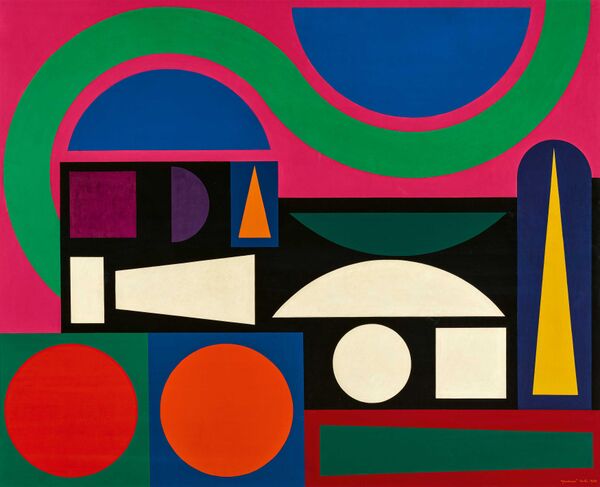Auguste Herbin
(French, 1882–1960)
Auguste Herbin was born in 1882 in Quievy, Nord, France. He studied drawing at the École des Beaux-Arts, Lille between 1898 and 1901, before moving to Paris, where he worked in isolation for several years. He moved into the Bateau Lavoir studios in 1909, and there he met Picasso, Georges Braque and Juan Gris.
Herbin's early works, such as 'Le Pont', 1906, and especially those that he sent to the Salon des Indépendants in 1906, illustrate the influence of Impressionism and Post-Impressionism. However, these influences became less visible after he encountered the work of the Cubists in Bateau-Lavoir. Between 1917 and 1921, his works were largely Cubist in style, sometimes incorporating pure geometrical elements. It was during this period that he was noticed by the art collector Léonce Rosenberg who exhibited his works at his Galerie de l'Effort Moderne on several occasions in 1918 and 1921. After receiving some negative remarks from critics, Herbin reverted temporarily between 1922 and 1925 to a more representational style, completing several portraits and landscapes during this period, such as 'Le Mont Ventoux à Sainte-Rusticule', 1924.
He returned to abstraction in 1926 and co-founded the artist group 'Abstraction-Création' with Vantongerloo in 1931. He produced several compositions made up of coloured geometric shapes at this time, such as 'Composition sur les noms communs: ange, lion, fauvette', 1942. In 1946 he developed, a compositional system based on the structure of letters ('alphabet plastique'), which he published three years later in his influential 'L'Art Non-Figuratif Non-Objectif'. He co-founded the 'Salon des Réalites Nouvelles' after World War II and became its president in 1955.
Herbin's architectural approach and use of colour has made his work widely known in the international art world. A major retrospective of his work was held at the Guggenheim Museum in New York in 1979 and several of his paintings were included in the exhibition 'Positionen unabhängiger Kunst in Europa um 1937' at the Kunstsammlung Nordrhein-Westfalen in Düsseldorf in 1987.
Remaining on the periphery of twentieth-century ideologies without committing to any one of them in particular, it is precisely this eclectic mix of artistic styles that span his career that make Auguste Herbin an extremely fascinating figure.
Herbin died in Paris in 1960.

